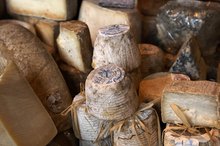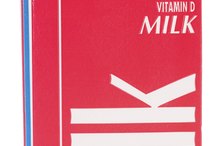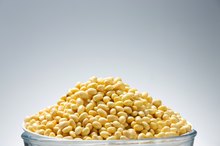Cheese Allergy & Rash
A rash that develops after you eat cheese may be a sign of an allergic reaction. Cheese is primarily made from milk, enzymes and sometimes mold. If you’re allergic to cheese, make an appointment with an allergist for testing to determine the cause of the allergic reaction. Most likely, you are allergic to milk or mold. After your diagnosis, avoid consuming all products that contain the allergen. Your doctor will help you create a modified diet plan.
Dairy Allergy
A milk allergy is considered a common food allergy and typically causes an allergic rash to develop. Milk contains two primary proteins: whey and casein. Whey proteins are found in the watery part of milk, while casein is used to make hardened dairy products, like cheese. You may be allergic to one or both of the proteins but should avoid milk products altogether because of the risk of cross-contamination. If you’re diagnosed with a milk allergy, talk with your doctor about ways to increase the amount of calcium and vitamin D in your diet.
- A milk allergy is considered a common food allergy and typically causes an allergic rash to develop.
- You may be allergic to one or both of the proteins but should avoid milk products altogether because of the risk of cross-contamination.
Mold Allergy
Cheese Allergy Symptoms
Learn More
It’s possible that your allergic reaction, including the rash, is the result of a mold allergy. Most allergic reactions to mold are caused by airborne mold spores during the spring, summer and fall months when humidity is high. If you’ve been diagnosed with a mold allergy, avoid eating cheeses that contain mold, such as blue cheese. Mold can exist in cheese without it developing into a visible form. Talk with your doctor about which cheese products are considered safe with a mold allergy.
- It’s possible that your allergic reaction, including the rash, is the result of a mold allergy.
- Talk with your doctor about which cheese products are considered safe with a mold allergy.
Rashes
A rash that forms from an allergic reaction to a food may cause hives, eczema or general skin inflammation. Hives can form anywhere on the body and typically develop in clusters with defined borders. They can appear in various shapes and sizes and can move from one part of your body to another in a matter of minutes with no reason. Eczema can be triggered by a food-related allergy, causing bumps to form on your body that are itchy and red. Eczema bumps will blister, crack, ooze and crust over and can leave your skin thick and leathery. General inflammation may appear red and swollen and can itch.
- A rash that forms from an allergic reaction to a food may cause hives, eczema or general skin inflammation.
Consideration
If You Are Allergic to Milk Can You Eat Yogurt
Learn More
If you experience an allergic reaction after eating cheese, you will develop more symptoms than just a skin rash. Other common symptoms related to a milk and mold allergy include asthma, digestive complications and sinus congestion. If you notice your face is swelling or you cannot breathe, call 911 because you may be experiencing a severe allergic reaction.
Related Articles
References
- MayoClinic.com: Milk Allergy; Aug. 12, 2009
- Kids Health: Milk Allergy
- Amirhosein Ghaffarianhoseini, Husam AlWaer, Hossein Omrany, Ali Ghaffarianhoseini, Chaham Alalouch, Derek Clements-Croome & John Tookey (2018) Sick building syndrome: are we doing enough?. Architectural Science Review,61:3, 99-121.
- American College of Allergy, Asthma & Immunology. Mold Allergy. Reviewed April 23, 2018.
- Centers for Disease Control and Prevention. Fungal Diseases. Reviewed May 6, 2019.
- Centers for Disease Control and Prevention. Mold. Basic Facts. Reviewed December 20, 2017
- Asthma and Allergy Foundation of America. Mold Allergy. Reviewed October 2015.
- Centers for Disease Control and Prevention. Molds in the Environment. Rreviewed December 20, 2017.
- Asthma and Allergy Foundation of America, Mold Allergy
- Centers for Disease Control and Prevention (CDC), Mold, Basic Facts
- Rudert A, Portnoy J.Mold allergy: is it real and what do we do about it?Expert Rev Clin Immunol. 2017 Aug;13(8):823-835. doi: 10.1080/1744666X.2017.1324298. Epub 2017 May 17.
Writer Bio
Diane Marks started her writing career in 2010 and has been in health care administration for more than 30 years. She holds a registered nurse license from Citizens General Hospital School of Nursing, a Bachelor of Arts in health care education from California University of Pennsylvania and a Master of Science in health administration from the University of Pittsburgh.









